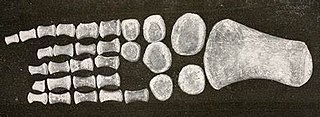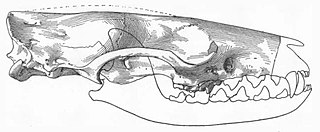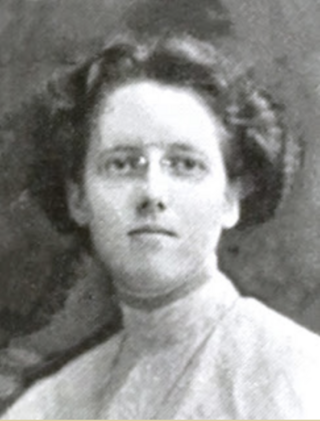Related Research Articles

Jean Baptiste Alphonse Déchauffour de Boisduval was a French lepidopterist, botanist, and physician.

Ludlow Griscom was an American ornithologist known as a pioneer in field ornithology. His emphasis on the identification of free-flying birds by field marks became widely adopted by professionals and amateurs. Many called him "Dean of the Birdwatchers."

Brontosaurus is a genus of gigantic quadruped sauropod dinosaurs. Although the type species, B. excelsus, had long been considered a species of the closely related Apatosaurus and therefore invalid, researchers proposed in 2015 that Brontosaurus is a genus separate from Apatosaurus and that it contains three species: B. excelsus, B. yahnahpin, and B. parvus.
Lieutenant Colonel Arthur Maitland Emmet MBE was an amateur entomologist and a former schoolmaster who taught Latin, English and Ancient Greek. He was a former president of the British Entomological and Natural History Society, a former president of the Amateur Entomologists' Society, and a vice-president of the Royal Entomological Society, having been elected a fellow of that society in 1984. Among other positions held in relation to his entomological work are:
Beaumont Newhall was an American curator, art historian, writer, photographer, and the second director of the George Eastman Museum. His book The History of Photography remains one of the most significant accounts in the field and has become a classic photographic history textbook. Newhall was the recipient of numerous awards and accolades for his accomplishments in the study of photo history.

Francis Huntington Snow was an American naturalist and educator. He spent more than forty years at the University of Kansas, first as a professor of natural history and then as chancellor. He was interested in several fields of science including botany, ornithology and geology but his primary focus was entomology. He was well-known as a field naturalist, based on 26 years of field collecting trips that he organized and led throughout Kansas, Arizona, Colorado, New Mexico and Texas. During these excursions, he and his students collected a quarter-million insect specimens representing some 21,000 species.

Paul Carpenter Standley was an American botanist known for his work on neotropical plants.
Clifford Hillhouse Pope was a noted American herpetologist. He was the son of Mark Cooper Pope and Harriett Alexander (Hull) Pope, and grew up in Washington, Georgia. While in college in the summers of 1919 and 1920 Pope went to the New York Zoological Society's Tropical Research Station at Katabo Point British Guiana, maintained by William Beebe. Starting in 1921, after graduating from the University of Virginia, he spent many years in China as part of the Central Asiatic Expeditions of the American Museum of Natural History, accompanying Roy Chapman Andrews on the expedition to the Gobi desert that first discovered fossilized dinosaur eggs. Pope mastered the Chinese language and made a total of eight expeditions in Chinese territory prior to 1930. In China he gave scientific names to the Kuatun horned toad, Hyla sanchiangensis, Amolops chunganensis, Rana fukienensis, and others. He also did a great deal of work with Karl Patterson Schmidt. Pope worked at the American Museum of Natural History from 1921 to 1934. He was president and journal editor of the American Society of Ichthyologists and Herpetologists in 1935.

Ogmodirus is an extinct genus of plesiosaur found in the Cenomanian-Turonian Greenhorn Limestone of Kansas. The type species, O. martini, was named by Samuel Wendell Williston and Roy Lee Moodie in 1913.

Nels Christian Nelson was a Danish-American archaeologist.
Gilbert L. Voss was an American conservationist and oceanographer. He was one of the main persons behind the establishment of John Pennekamp Coral Reef State Park in Florida and he spoke out successfully against several proposed real estate developments that might have threatened the ecology of the Florida Keys.

Paul Austin Johnsgard was an ornithologist, artist and emeritus professor at the University of Nebraska. His works include nearly fifty books including several monographs, principally about the waterfowl and cranes.
Craig Call Black (1932–1998) was an American paleontologist noted for his studies of the vertebrate mammals of the Ice Age. He served as the director of the Museum of Texas Tech University 1972-1975, Carnegie Museum of Natural History 1975-1982 and the Natural History Museum of Los Angeles County 1982-1994. In 1982, President Ronald Reagan appointed him to serve on the National Museum Services Board. In 1985, Reagan nominated him to serve on the National Science Board for a period of five years succeeding David V. Ragone. In 1991, President George H. W. Bush appointed him to serve on the Environment for the Americas Board.

The Wasatch Formation (Tw) is an extensive highly fossiliferous geologic formation stretching across several basins in Idaho, Montana Wyoming, Utah and western Colorado. It preserves fossils dating back to the Early Eocene period. The formation defines the Wasatchian or Lostcabinian, a period of time used within the NALMA classification, but the formation ranges in age from the Clarkforkian to Bridgerian.
The Washakie Formation is a geologic formation in northern Colorado and southern Wyoming. It preserves many mammal, bird, reptile and other fossils dating back to the Lutetian stage of the Eocene within the Paleogene period. The sediments fall in the Bridgerian and Uintan stages of the NALMA classification.

The Bridger Formation is a geologic formation in southwestern Wyoming. It preserves fossils dating back to the Ypresian Epoch of the Paleogene Period. The formation was named by American geologist Ferdinand Vandeveer Hayden for Fort Bridger, which had itself been named for mountain man Jim Bridger. The Bridger Wilderness covers much of the Bridger Formation's area.

Viverravus is an extinct genus of placental mammals from extinct subfamily Viverravinae within extinct family Viverravidae, that lived in North America, Europe and Asia from the middle Paleocene to middle Eocene.

Roger Lansing Grande, more commonly known as Lance Grande, is an evolutionary biologist and curatorial scientist. His research and work is focused on Paleontology, Ichthyology, Systematics and Evolution. He is best known for his work on the paleontology of the Green River Formation and for his detailed monographs on the comparative anatomy and evolution of ray-finned fishes.
The Williams Conservatory is located in Laramie, Wyoming at the campus of the University of Wyoming. It opened in 1994. The main greenhouse is filled with exotic plants from various climates and biomes. The Conservatory is open daily for public and it receives hundreds of visitors each year.

Marjorie O'Connell Shearon was a palaeontologist from Newark, New Jersey. She earned a master's degree and a PhD from Columbia University. She wrote numerous scientific articles and named various species of ammonite fossils as Marjorie O'Connell, her maiden name before she married William Shearon in 1927.
References
- ↑ Burger, William (May 1991). "Louis Otho Williams (1908-1991)". Taxon. 40 (2): 355–6. JSTOR 1223002.
- ↑ Natural History Museum bio
- ↑ Field Museum page
- ↑ Williams, Louis. "Central America and Peru". Field Museum of Natural History.
- ↑ International Plant Names Index. L.O.Williams.